
Monday May 3, 2021
Day 7: Stone Creek to Above Olo Camp, Mile 146

Our boats look miniature down at the Colorado River’s edge from the vantage which took us up to Deer Creek Falls.
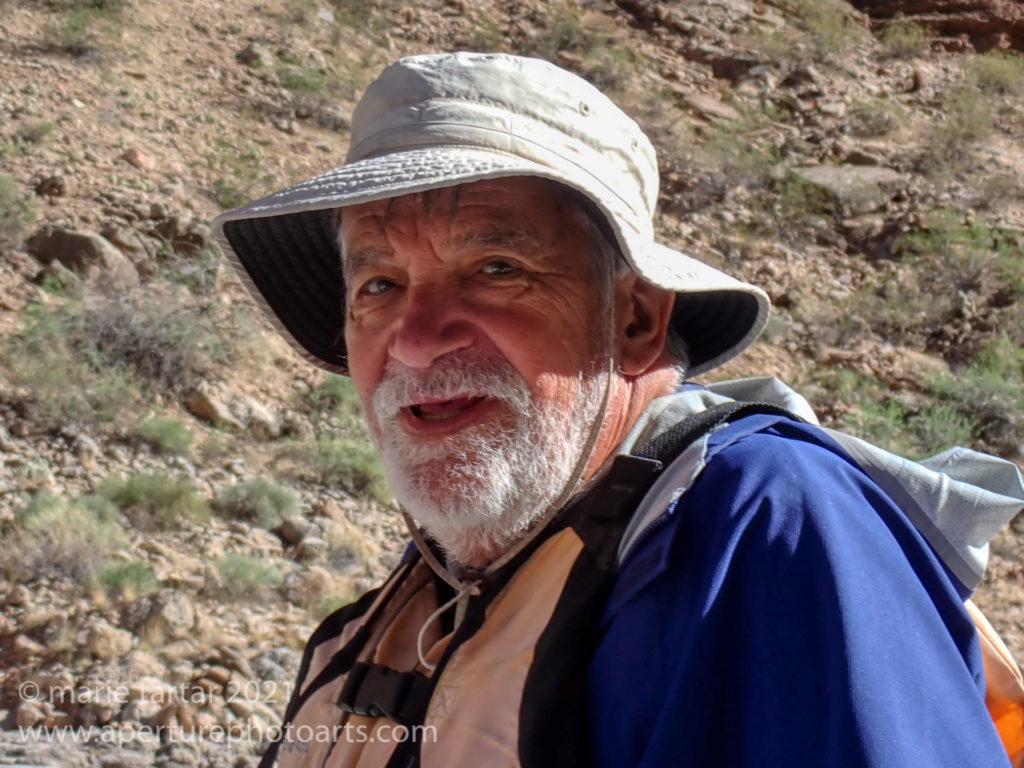
Art, a kind retired tech transfer prof from Penn State, spent two of his early retirement years as a Peace Corp volunteer in Botswana.
Our stop for the night was further downstream, at Mile 146, the Above Olo camp.
Our dinner of pork chops, sautéed potatoes and onions, with asparagus culminated in the best dessert of the trip, a terrific Dutch oven preparation of a soft ginger bread. A huge tarantula hawk tried to get in on the action, buzzing us at dinner repeatedly.
After dark, I borrowed Bug’s florescent flashlight. Jim accompanied me on an unsuccessful hunt for scorpions after dark. Apparently, it was too cold.
Tuesday, May 4, 2021
This was a long and eventful day, starting very early, with a handful of us rising at 3 AM to shoot the Milky Way. Bill, Adam, Joe, Chris, Scott and I crept around in the dark, red points of light in the darkness, trying not to wake up the others sleeping nearby. Most went back to sleep after the Milky Way faded in prominence towards 4 AM, to catch another hour’s sleep. During our shoot, the moon illuminated the top edge of the opposite canyon wall.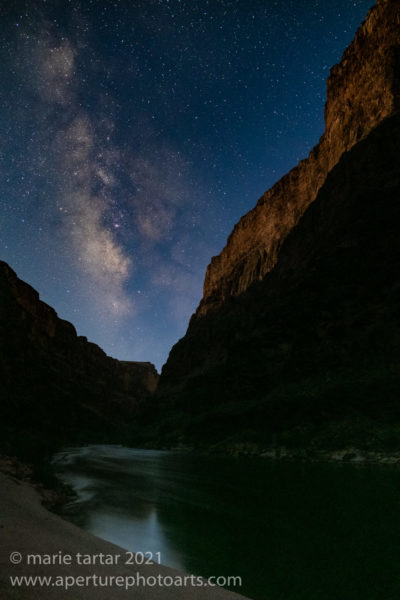
We had but a short run to our next destination, just down the road and a big hike to our shoot in Matkatamiba “Matkat” Canyon.
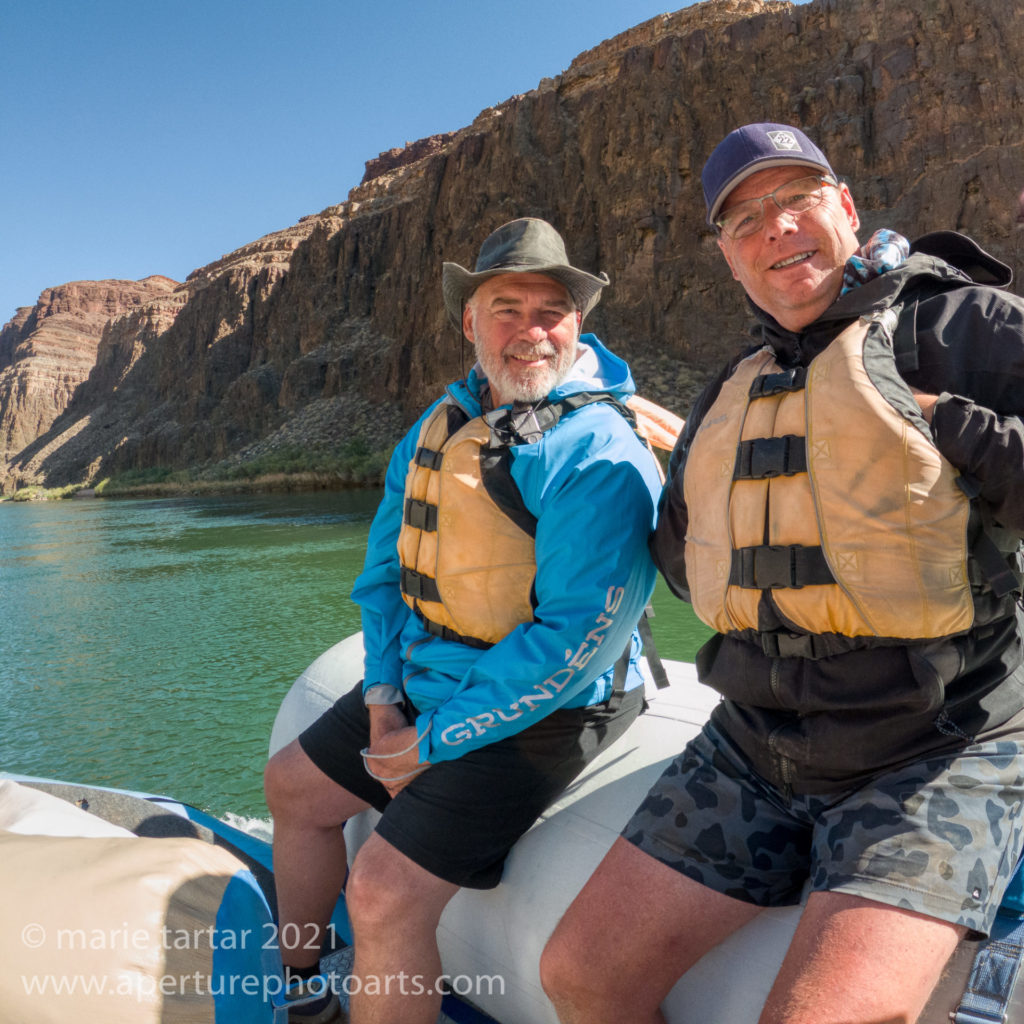
Chris and Scott, friends and former neighbors from the Ann Arbor area, had no trouble with the higher water crossings. They were tall and strong and so helpful to me, Scott wrestling my big Watershed camera bag into submission most mornings and both willing to tote heavy gear from landing to camp and back.
The guides (with the help of Sally as chief chicken shredder) quickly erected a sunshade and whipped up a lunch of chicken salad and sandwich fixings, including a new offering: bacon.
We had a little scare on our departure. Kyle was backing the S rig off the sand. Usually, another guide would jump-start the egress by pushing the boat from the beach and leaping on at the last minute. Somehow, red-haired Jake wasn’t quite all the way on when the boat caught the current. He was dragged for a scary minute through a rapid, hanging on to the back of the boat.

Two of our four outstanding Tour West guides, both named Jake, in a quiet moment on the Colorado River in Grand Canyon. Red-haired Jake (in back) was inadvertently dragged for a short swim while pushing off from lunch. “Jesus” Jake (in front) astounded Art and me reciting long stretches of poetry from memory while sweeping on the hikes.
There were more challenges for the guides in store, with the motor conking out on the baby J. The guides had to swap it out for the spare while we lunched, bringing us down to 2 out of 4 working motors for the trip, with miles to go to take-out. With all that, the planned run on Lava, one of the biggest and most notorious of the rapids, was deferred until the following day.
Wednesday, May 2021
Day 9: Fern Glen to Pumpkin Springs Camp, Mile 213
This was a hot and draggy day. Lava was a roller coaster of a ride, at least for those of us in the S rig. The riders in the baby J said they didn’t receive a splash. Lava Falls is one of the most feared and difficult rapids in the Canyon and in the world. Major Powell did not run it. At the time, the debris flow from Prospect Canyon, the second largest debris fan in Grand Canyon (behind Kwagunt Creek) constricted the river 3%; now, the river is narrowed 50%!

On a calmer stretch of the Colorado River, the big camera rigs can be dug out of waterproof bags hanging from straps cinching down the gear. Jim (in back) has been living in an RV since retiring ; Adam (in front) is a former artist-in-residence at Grand Canyon and our photographic leader and trip organizer.
At Mile 187, we passed the helipad at Whitmore Wash. A chopper was just arriving, landing on a tiny scrap of a helipad.

Gulp-I really don’t remember the helipad looking so…improvised. This was how Steve and I arrived on our dory trip in the 1990s, zooming down dramatically over the lip of the Canyon.
Our final camp, Pumpkin Spring, is named for a very distinctive formation resembling a giant pumpkin in both shape and color, a travertine bowl dripping suspect water into the river.

Pumpkin Spring Camp at Mile 213, named for the colorful travertine bowl to the left, a hot and exposed camp.
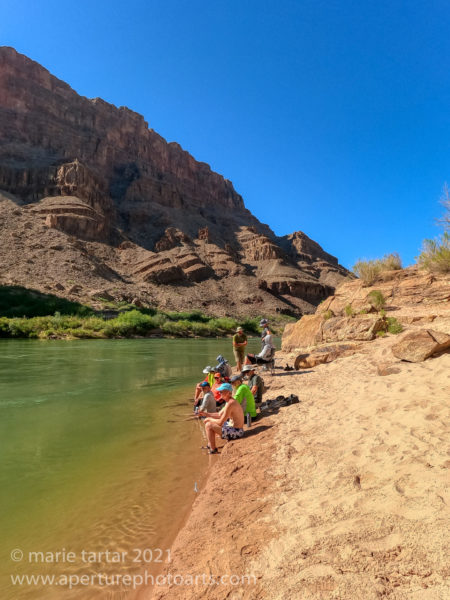
Until the sun retreated, there was no relief from its unrelenting glare at Pumpkin Spring Camp but putting one’s feet (and more) into the Colorado River’s constant cool.
The camp itself was steep and sandy. The Groover was at the end of an obstacle course opposite the camping sites. The drop-offs were steep enough that Bugs insisted that anyone venturing off in search of photographic viewpoints wear their life-jacket!
I was to trek this sandy path multiple times during the night. While it was still light, I scouted a viewpoint and planted my tripod, safely back from the drop-off. After dinner, I set up a long exposure (30 minutes), with 30 minutes of noise reducing in-camera processing. I could hear snatches of conversation from the direction of camp. At one point, I thought I heard someone exclaim “Safe sex!” Since Chris and Scott has been continuously teasing Bill and Ann for PDA (public displays of affection), I thought they must be joking around. A few seconds later, I saw an astounding sight in the dark night, a train of light, like a cosmically electrified Santa’s sleigh: Space X, not safe sex!
To do a 30 minute exposure with my camera, I had to use the bulb function and a cable release, effectively a mechanical substitute for my finger holding the shutter down for 30 minutes. I started the exposure, then headed back to camp, temporarily forgetting that the cable release would not automatically cut off the exposure at the time appointed in my head. Back I trudged to my cot to pick up my toothbrush. I continued on to the beach to brush my teeth and from there to the other side of camp in search of the Groover, which was further and on a circuitous and rocky path. By the time I made it back to my cot, I was tired and ready to sleep. I brushed the sand off my sandaled feet and as soon as I lifted my feet onto the cot and my head made grateful contact with the pillow, I remembered my exposure in progress, which would be ruined if I didn’t attend to it. I heaved myself reluctantly out of bed and back up the sandy path.
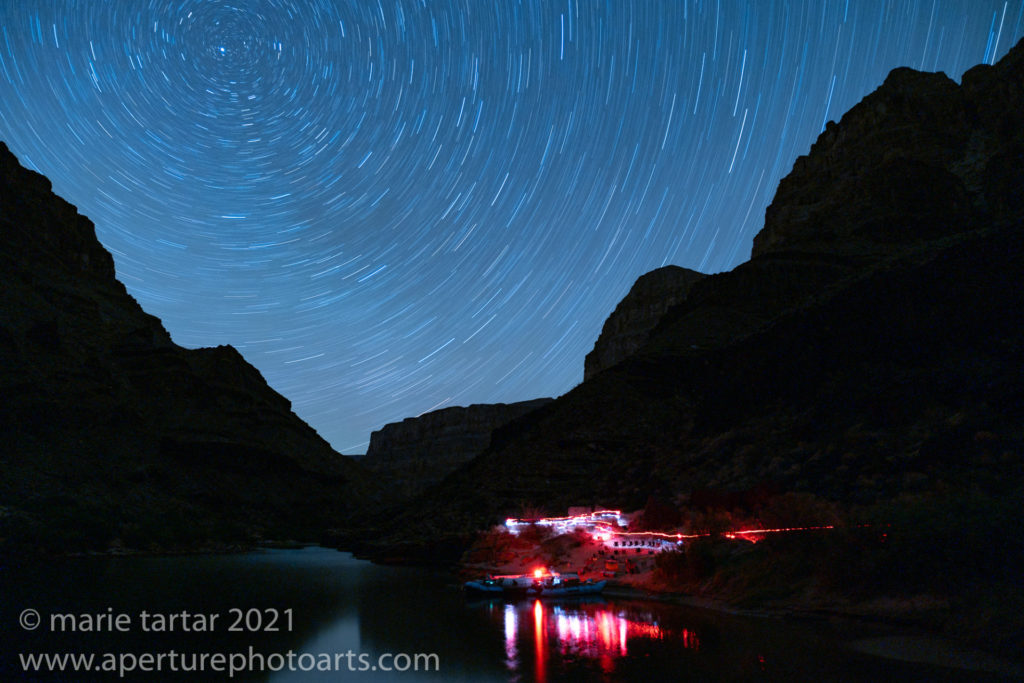
A strange self-portrait at Pumpkin Spring Camp: down at the water’s edge, our guides use red headlamps to maneuver around at night, shedding just enough light to see the blue of the boat’s pontoons. The streaks of red and white up above the boats? That’s me, heading toward the Groover, trying first with a red light, then eventually having to switch on the white light, taking a few twists and turns en route.
During the evening, Brian, Scott and I planned to arise at 3 am to take advantage of our final dark sky night, the glimmering Milky Way and the waning moon. I left my tripod in place. Photopills predicted the Milky Way would align with the slope of the canyon wall, although the brightest glow, with galactic center, would be in the opposite direction, where there was no water foreground. My third and final Fujifilm XT-4 battery was red and virtually spent when we headed back to camp. I had gone through both of my auxiliary batteries during the trip and managed to limp through with charging boosts from Kyle mid-trip and Brian on our last full day. I still had the little Sony with several batteries in reserve.
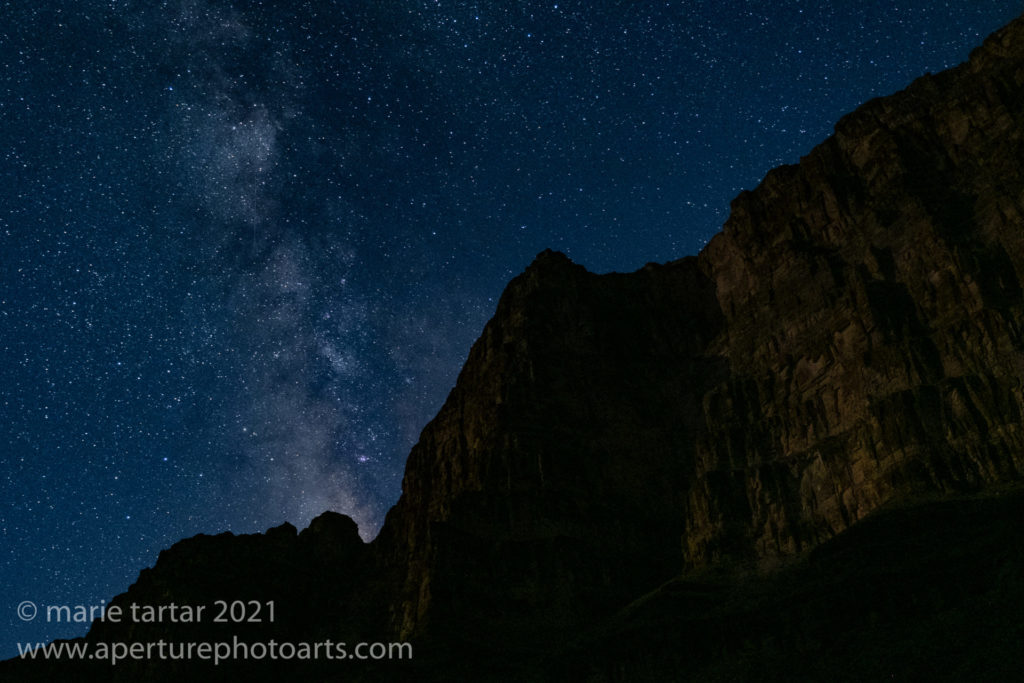
The Milky Way at Pumpkin Spring Camp, Mile 213, with the waxing moon rising in the middle of the night to shed a weak light on the opposite wall in Grand Canyon.
Thursday, May 6, 2021
Take out day, Pumpkin Spring to Diamond Creek, Mile 225
Adam says he ends his trips at Diamond Creek at Mile 225 because people tend to “check out” as the trip progresses. The alternative beyond this point is going all the way to the end, the Grand Wash Cliffs, which mark the end of Grand Canyon and entry into Lake Mead. I had been surprised Steve hadn’t wanted to join this trip when the opportunity presented itself. Now that I’ve seen what he missed, I think he probably was misled by our trip together on the lower Colorado, from Whitmore Wash to Lake Mead, a generally more languid (except for Lava Falls), open and definitely hotter section of the canyon. I also had to laugh at his perception that a river trip wouldn’t be active enough. The side canyon hiking options did seem more sparse further down.
When we arrived early to our take-out, there was work to do to speed our guides on their way to their more distant destination. After our gear was offloaded, the S rig needed to be disassembled. The two huge long pontoons needed to be deflated, a task involving us bouncing, lying and rolling down the length of the pontoon to express the air and roll them up.

At Diamond Creek in Grand Canyon at Mile 225, Adam shows how to deflate the S rig’s pontoons, with help from Joe, Ann and Bill.
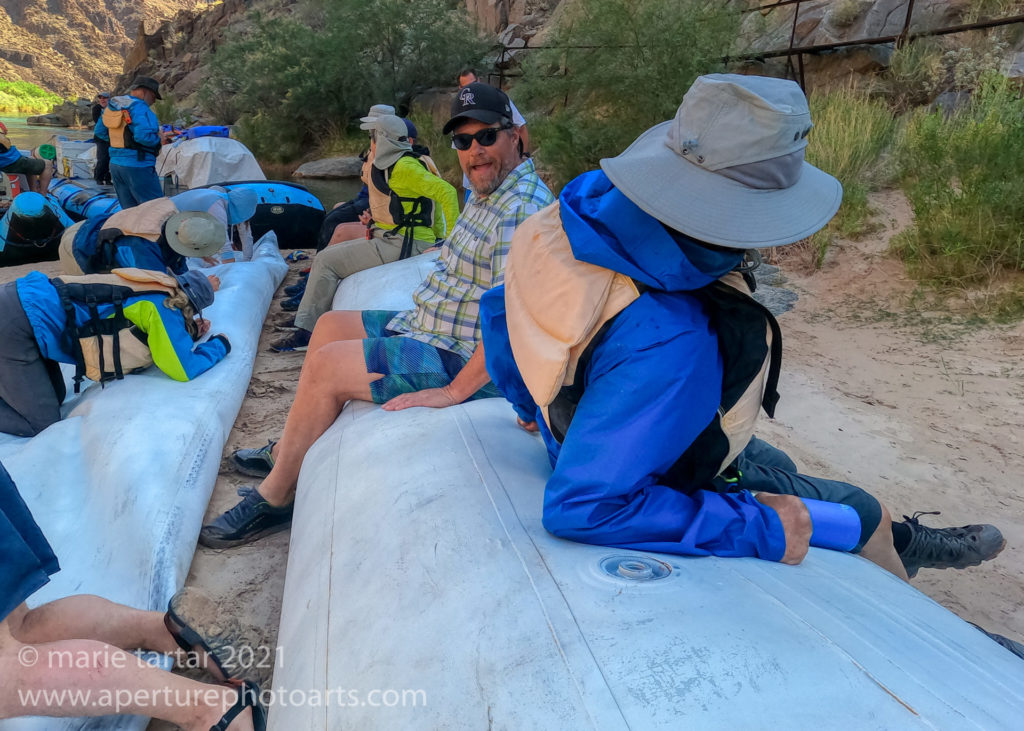
Our fearless leader, John or “Bugs”, having fun de-rigging the S rig, or less likely, delighted to be done with us?
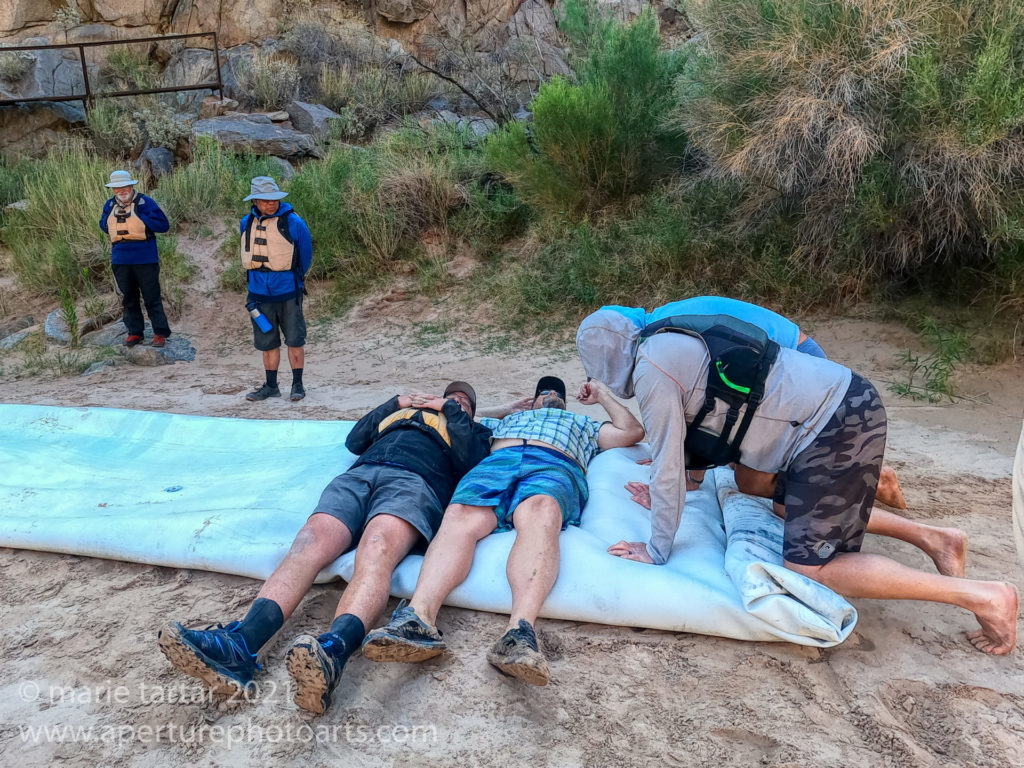
Scott and Bugs lend some weight to the task of keeping the air out of the deflated pontoons as the two Jakes start the big roll-up.
There was sobering news as we neared civilization, which had been intentionally withheld from us until we arrived safely at the end. The day before we launched, there was a death in the Canyon, resulting when a 37 foot motorized vessel much like ours, also on a commercial trip (Canyoneers) , flipped near Kwagunt at Mile 57. I learned more about the accident later from a report on American Whitewater’s website . Apparently, it struck a boulder and capsized, sending all of its passengers and two crew members into the river. This boat had storage boxes along both sides, forming a central aisle, creating a more difficult to escape well underneath. Two passengers were trapped under the boat, while others made their way to both shores. Three passengers were swept downstream, one of whom was unresponsive and could not be resuscitated despite prolonged CPR. The boat travelled down river half of a mile, with passengers clinging to it and trapped underneath, before entering an eddy, enabling all but those underneath to exit the river. They were rescued by a retired firefighter passenger, who shed his lifejacket in order to dive underneath the boat. The eddy eventually brought the boat close enough to shore for it to be dragged up. The passengers trapped under the boat were in the water long enough to be hypothermic. Sleeping bags were retrieved from the boat to warm them.
A commercial river trip from Wilderness River Adventures (WRA), arriving about 1.5 hours after the capsize, used a satellite phone to notify the Park Service. Boats were launched, but snow on the rim kept the rescue helicopter from mobilizing until the following morning, when the boats arrived. WRA transported the capsize passengers downriver to reunite with the other half of the trip at Mile 61.6, where they camped through a cold night, short on sleeping bags, pads and tents. The following morning, the deceased and two passengers with shoulder injuries were flown by helicopter to the rim, with the rest of the group taken 30 miles downriver to Phantom Ranch, where they stayed the night before being transported or hiking out.
Poor Steve learned about this incident before I did and thought, at least for half an hour, that he might be a widower. After dropping me off early on Tuesday in a flurry of snow, he returned to Sedona to catch a few hours of sleep before heading to the Granite Dells in Prescott to shoot the sunset. Departing for his solo photography trip to Utah and New Mexico the following morning, , he heard a snatch of a news story on the radio while driving up Oak Creek Canyon: “….accident in Grand Canyon…motorized raft flipped…a woman around 60 years of age killed…” It wasn’t until he reached Flagstaff and had a little cell reception that he could ask Siri to find him a news article with the date of the accident that he realized the victim couldn’t have been me, since this happened on Monday, the day before our launch.
I learned about this accident before most of our passengers, a few days into the trip, from Scott, who had access to a satellite phone. I kept it quiet, no need to cast a pall over the trip. As if I need any more reminders, being in health care, how quickly one’s circumstances can change. What a sad and tragic event and a terrible contrast to our triumphant traverse of the Canyon. Unpacking back at home, I had a strange demonstration of the jarring power of the river. Inside the large Ziploc with my toiletries, I hadn’t noticed over the course of the trip that a pack of 5 disposable contact lenses, connected together at the beginning of the trip and requiring care to separate from each other, had torn apart from each other and separated.
We had traveled through eons of geologic history, with younger rock layers giving way to older as we progressed.
A convenient mnemonic for the successive layers, is from the top (rim) to bottom (river): Know The Canyon’s History, Study Rocks Made By Time, Very Slowly. The layers :
- Kaibab Limestone
- Toroweap Limestone
- Coconino Sandstone
- Hermit Shale
- Supai Group (a mix of sandstones, shales, and limestones)
- Redwall Limestone
- Muav Limestone
- Bright Angel Shale
- Tapeats Sandstone
- Vishnu Schist
The contributory and competitive processes of deposition, uplift, down-cutting and erosion molding the Canyon’s contours are an astounding display of geologic forces at work. The history of explorers and adventurers in Grand Canyon also came alive around each bend. We took out before reaching Mile 232 Rapid, the probable end to the journey for Bessie and Glen Hyde, a young couple whose mysterious disappearance in 1928 is the subject of Grand Canyon river guide and boatbuilder Brad Dimock ‘s Sunk Without a Sound: The Tragic Colorado River Honeymoon of Glen and Bessie Hyde, which kept me mentally on the river in the weeks following our trip and was a welcome distraction from the ransomware disaster that awaited me back at work. The Hyde’s boat was found 5 miles further downstream 3 weeks after they were last seen, upright and provisioned, even with Bessie’s journal. The author traces out skillfully the threads of the tale, which has been an enduring mystery and the subject of speculation for decades, as their bodies were never found.
It’s amazing to realize how ancient the Canyon is, yet how recent is the Western world’s exploration and mapping of the Colorado in Grand Canyon. John Wesley Powell’s historic traverse was in 1869, with the sesquicentennial (150 year) anniversary in 2019. At the time of the Hyde’s trip in 1928, only 45 people had successfully made the voyage. Bessie would have been the first woman. The era of commercial, comparatively comfortable, trips like ours was still decades away. Even today, with the best of modern equipment, the river runner experiences extremes of temperature and exertion and some discomfort. Death in Grand Canyon is still a real possibility-there is even a book detailing the many ways people have perished in the Canyon (Over the Edge: Death in Grand Canyon) which I may well read before the canyon loosens its spellbinding grip on me. For now, I’m prolonging the pleasure with bedtime reading of There’s This River, a collection of Grand Canyon boatmen stories while also contemplating a third reading of the tale that launched me on this odyssey, the one to read if there’s only time for one, The Emerald Mile.
-Marie

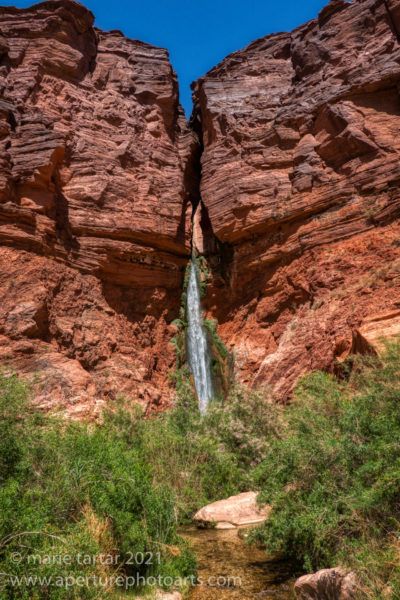
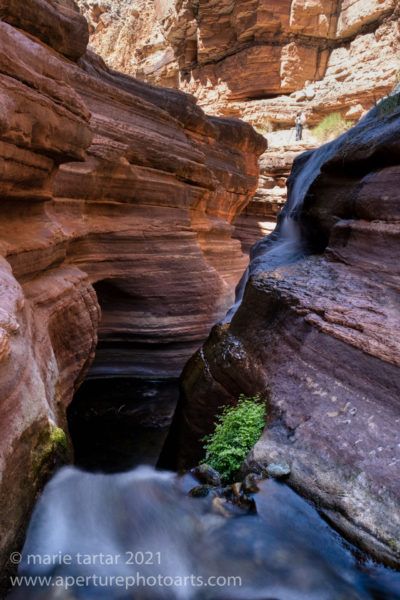
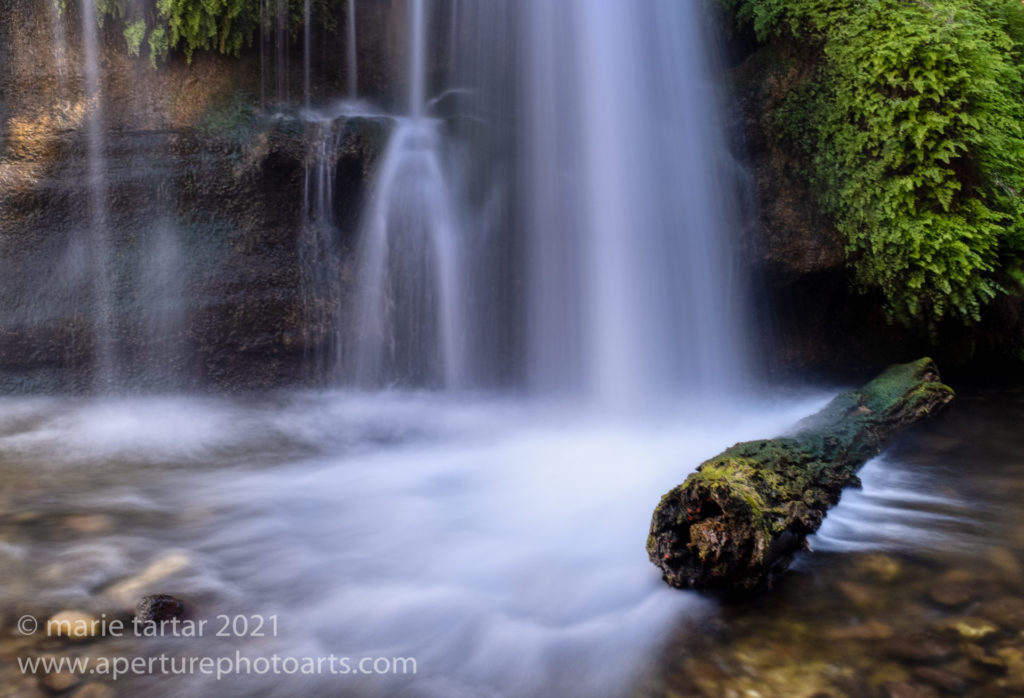


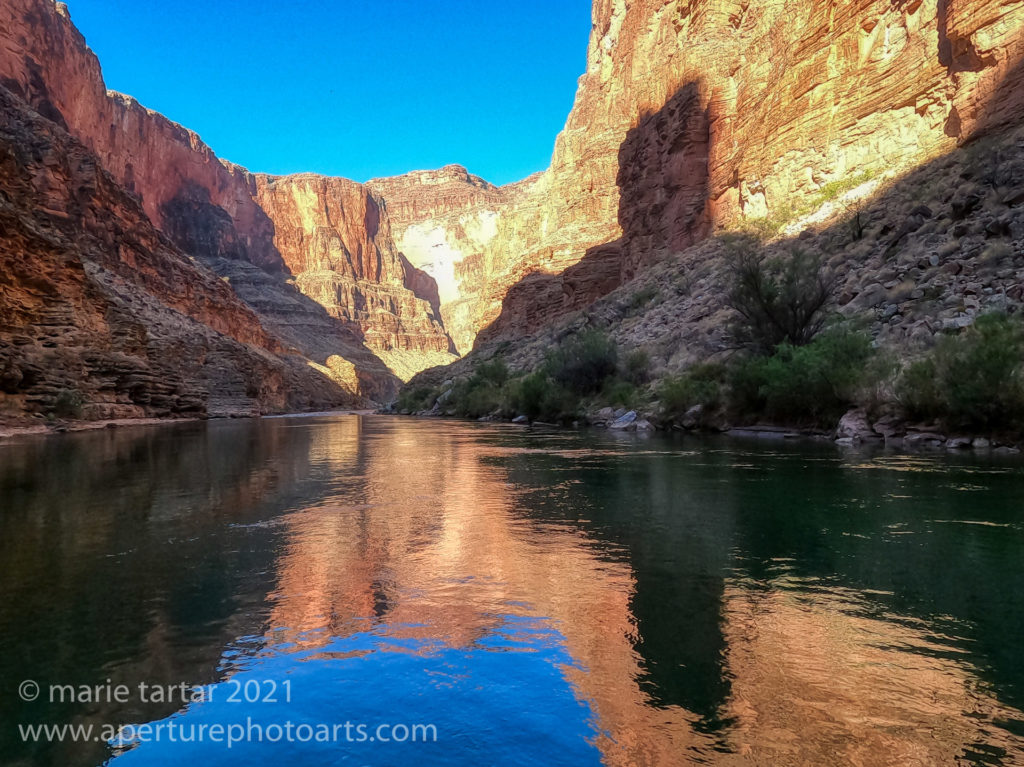
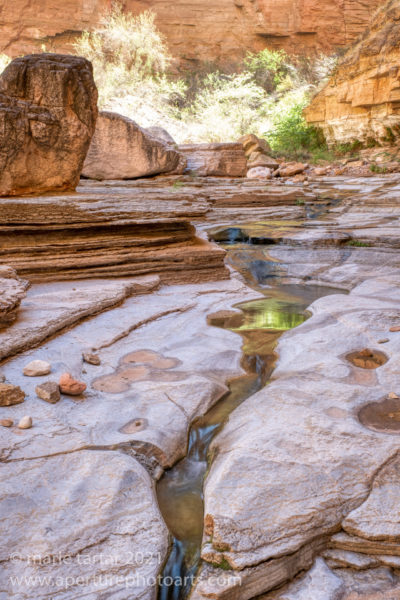
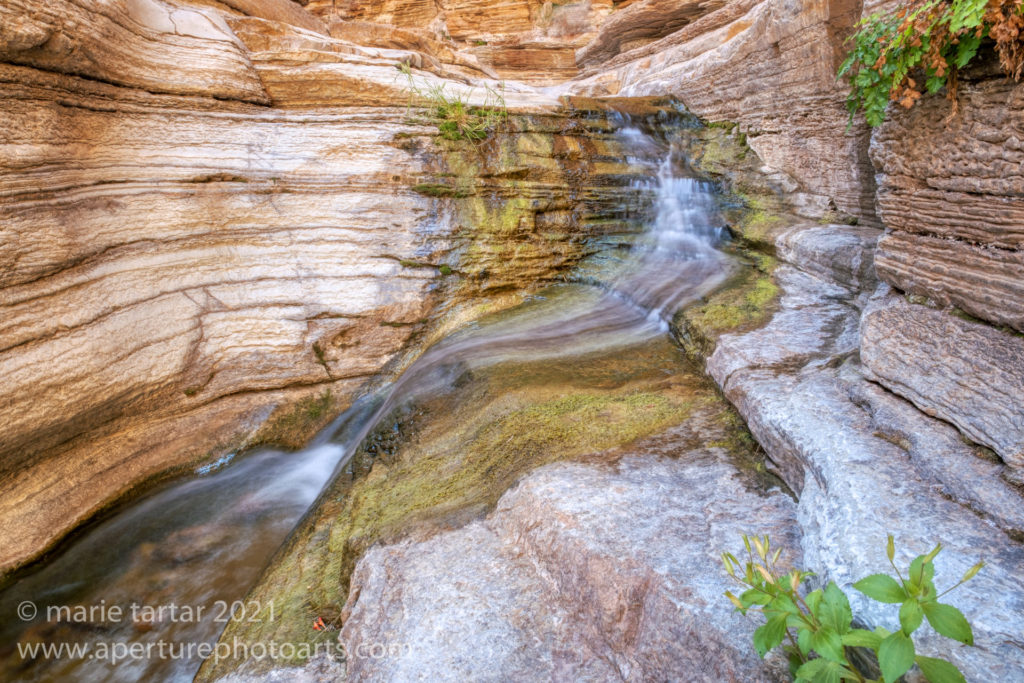

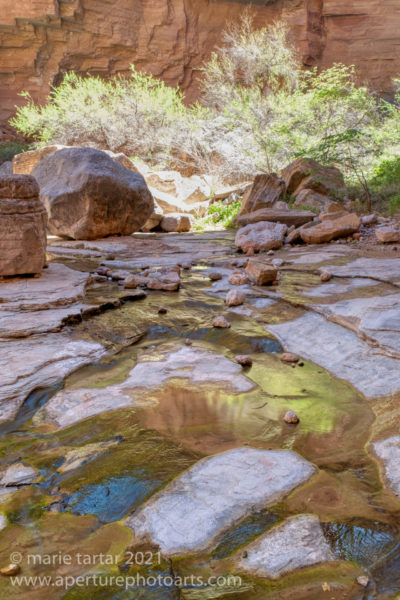
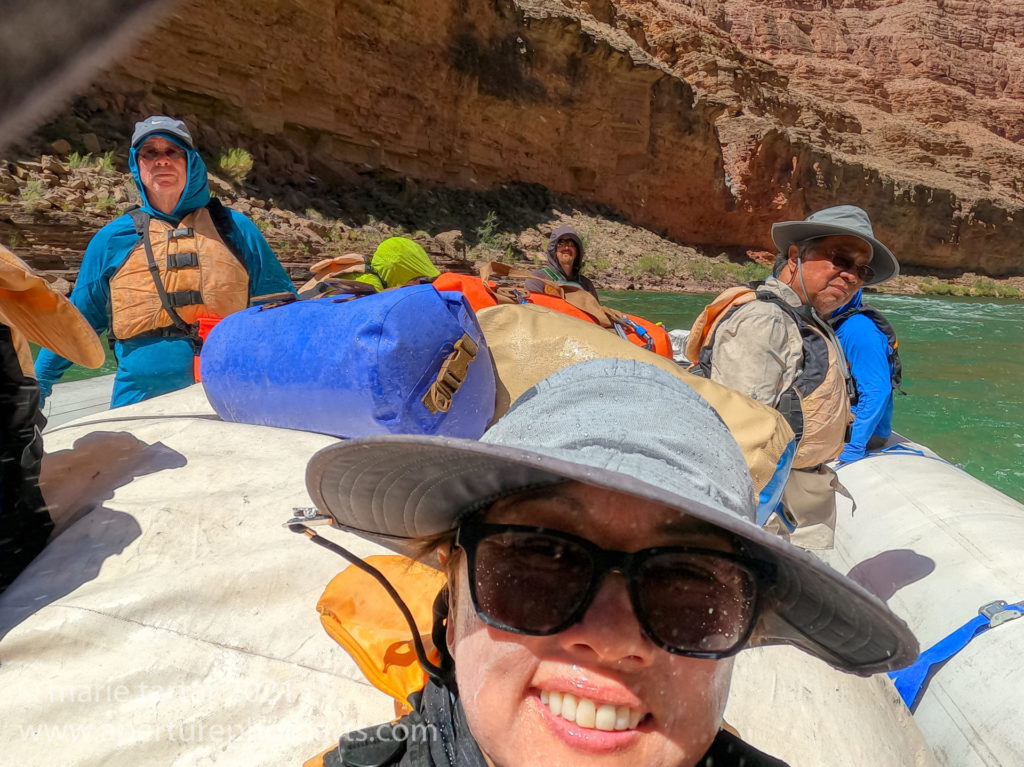
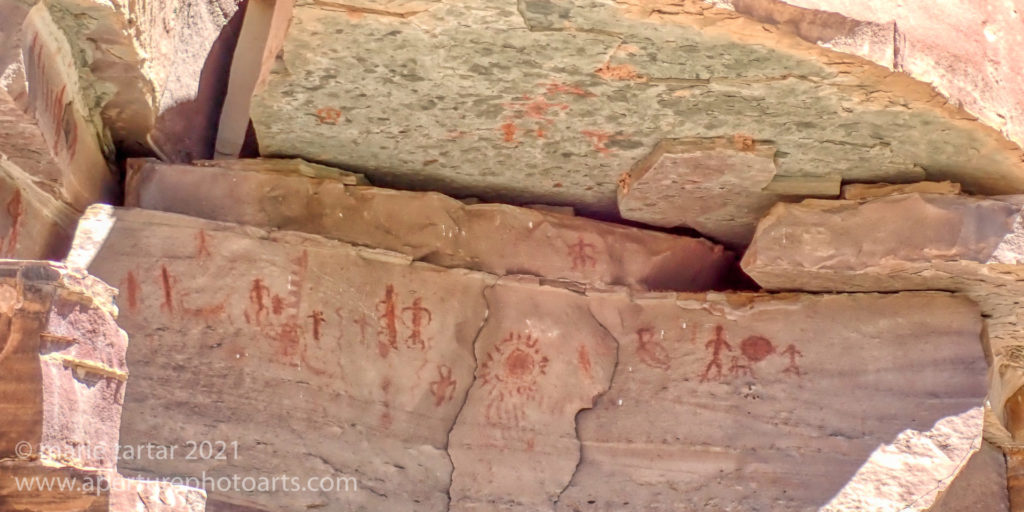

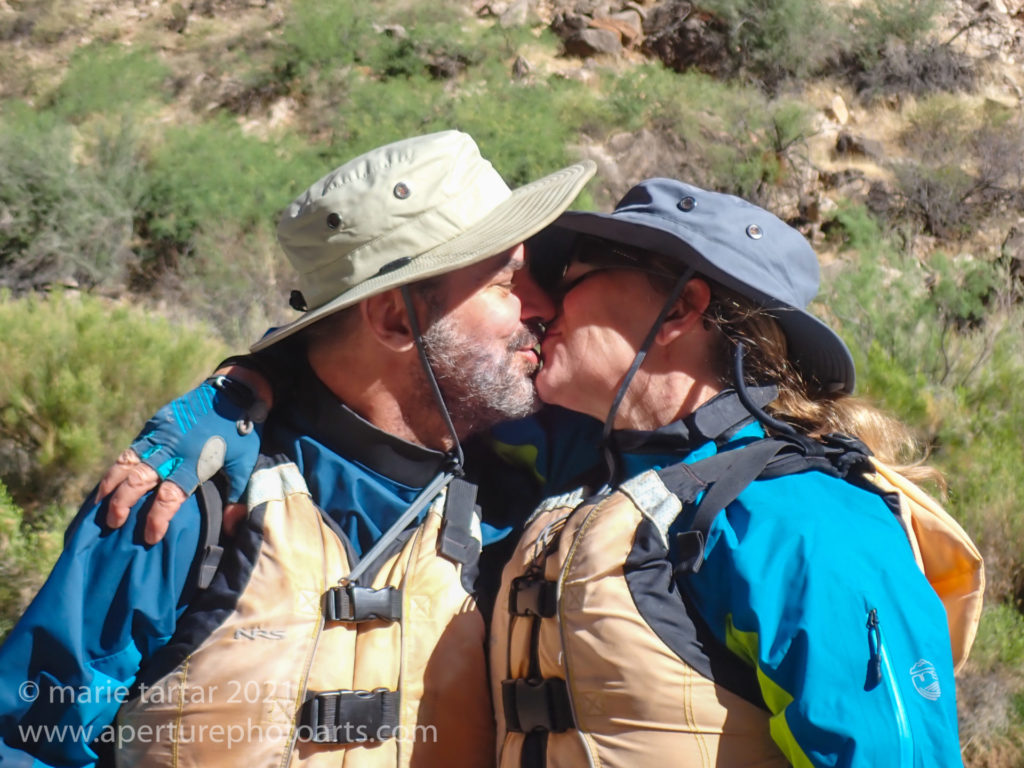

Mesmerized by your narrative & spellbound by your photos! The age of your fellow rafters has me thinking of adding a Grand Canyon adventure to our travel list. I look forward to hearing more.
Steph,
It’s definitely a bucketlist trip I highly recommend!
-Marie